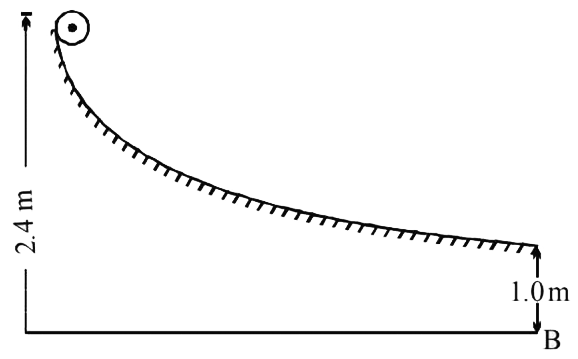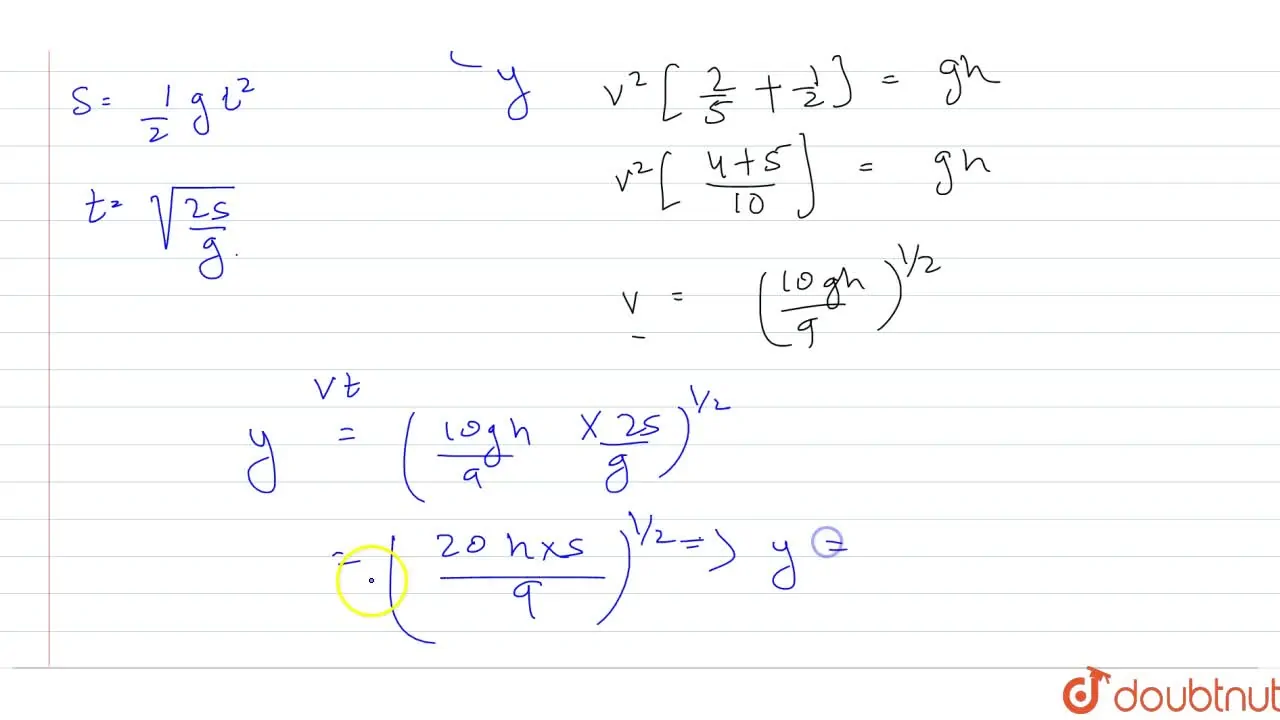A small sphere rolls down without slipping from the top of a track in a vertical plane. The track has an elevated section and a horizontal part. The horizontall part is 1.0 meter above the ground level and the top of the track is 2.4 meter above the ground. Find the distance on the ground with respect to a point B( which is vetically below the end A of the track as shown in fig.) where the sphere lands.
 .
.
(A) 1m
(B) 2m
( C) 3m
(D) 4m.
(B) Let m be the mass and r the radius of the sphere. Let v and ω be the linear and angular velocities at A. In rolling down from the top of the track to the point A the sphere loses potential energy which appears as linear and rotational kinetic energies in the sphere. Thus
mgh=12mv2+Iω2
But I=25mr2 and ω=vr
mgh=12mv2+12(25mr2)v2r2
mgh=12mv2
or v2=107gh,
Here h−(2.4−1.0)=1.4meter
v=√(107gh)=
⎷(10g(1.4)7)=√2g
v is the horizontal velocity of the sphere at A. The vertical velocity at A is zero. If t is the time taken in covering the vertical distance AB(=1.0m), then using the formula h=1/2>2, we have.
⇒t=√(2hg)=√(2g)(∵h=1.0m)
The horizontal distance moved in time t=v×t
=√2g×√(2g)=2m
During the flight the sphere continues to rotate about its centre of mass due to conservations of angular momentum.
Similar Questions
A small sphere rolls down without slipping from the top of a track in a vertical plane. The track has an elevated section and a horizontal part, The horizontal part, is 1.0 metre above the ground lenvel and the top of the track is 2.4 meters above the ground. Find the distance on the ground with respect to the point B (which is vertically below the end of the track as shown i fig.) where the sphere lands. During its flight as a projectlie, does the sphere continue to rotate about its centre of mass? Explain.
 View Solution
View SolutionThe part of mushroom that is visible above the ground is a
View SolutionAn elevator is 25 m below the ground level and it ascends at the rate of 5mmin . Find the time takenby it to reach 50 m above the ground.
View SolutionPart of the mushroom visible above ground is
View SolutionA man whose eye leave is 1.5 meters above the ground observes the angle of elevation of the tower to be 60∘. If the distance of the man from the tower be 10 meters, the height of the tower is
View SolutionThe upper part of a tree broken over by the wind makes an angle of 60∘ with the ground and the horizontal distance from the foot of the tree to the point where the top of the tree meets the ground is 10 metres. Find the height of the tree before broken.
View SolutionThe angle of elevation of the top of a vertical tower PQ from a point X on the ground is 60o . At a point Y , 40m vertically above X , the angle of elevation of the top is 45o . Calculate the height of the tower.
View SolutionA ball is thrown from the top of a tower of 61m high with a velocity 24.4ms−1 at an elevation of 30∘ above the horizontal. What is the distance from the foot of the tower to the point where the ball hits the ground?
View SolutionA tower stands vertically on the ground. From a point on the ground which is 30 m away from the foot of a tower, the angle of elevation of the top of the tower is found to be 45∘. Find the height of the tower.
View SolutionA small solid sphere of radius r rolls down an incline without slipping which ends into a vertical loop of radius R. Find the height above the base so that it just loops the loop
View Solution


